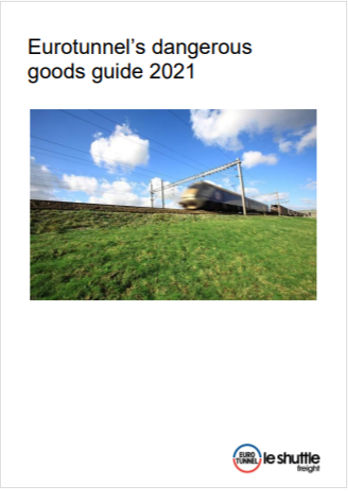
Eurotunnels 2021 ADR Dangerous Goods Regulated
I – Introduction to Eurotunnel’s dangerous goods policy
II – Definition of terms used
III – List of dangerous goods accepted
Class 1: Explosive substances and articles
Class 2: Gases: compressed, liquefied or dissolved under pressure
Class 3: Flammable liquids
Class 4.1: Flammable solids
Class 4.2: Substances liable to spontaneous combustion
Class 4.3: Substances, which in contact with water, emit flammable gases
Class 5.1: Oxidizing substances
Class 5.2: Organic peroxides Class
6.1: Toxic substances Class
6.2: Infectious substances
Class 7: Radioactive materials Class 8: Corrosive substances
Class 9: Miscellaneous dangerous substances and articles
IV - What to do on arrival at the Freight Terminal
V - Eurotunnel contact details
I – Introduction to Eurotunnel’s dangerous goods policy The Channel Tunnel has been designed to be one of the safest transport systems known to date. Eurotunnel’s dangerous goods policy is therefore intended to ensure the safety of its customers and staff, and the integrity of the Tunnel. This policy has been produced in close collaboration with industry and with relevant trade and professional bodies.
The carriage of dangerous goods through the Channel Tunnel must comply with ADR (Agreement concerning the International Carriage of Dangerous Goods by Road).
Dangerous goods definitions are subject to the current revision of the ADR regulations and Eurotunnel Freight will accept, restrict or refuse goods on the basis of these definitions. This dangerous goods policy has been decreed by a By-Law in the UK and an Arrêté Ministériel in France and forms an integral part of Eurotunnel’s Conditions of Carriage.
The carriage of dangerous goods must also comply with Eurotunnel’s own regulations as described on this website, which are more stringent than those in ADR, to reflect the specific safety characteristics of the Channel Tunnel infrastructure.
The carrier is responsible for ensuring that the goods being transported comply with these regulations. Declarations must be made using the current revision of ADR applicable at the time of travel, in one of the official languages of ADR – English, French or German. Furthermore, it is also the carrier’s responsibility to provide the compulsory documentation, including for vehicles travelling under the provisions of ADR chapter 1.1.3.6.
Dangerous goods being carried under the ADR Limited Quantity, Excepted Quantity or any other Special Provisions, which do not need documentation, do not need to be declared at Check-in. However, if these goods are declared, a full ADR declaration must be provided. Eurotunnel Freight reserves the right to authorise or refuse carriage of dangerous goods via Eurotunnel Freight, irrespective of their type, origin and / or destination. The Channel Tunnel has been designed to be one of the safest transport systems known to date.
...
add more in attachment
Collegati
Allegati
|
Descrizione |
Lingua |
Dimensioni |
Downloads |
 |
|
EN |
894 kB |
842 |

































